 p317 _
-chap- _
toc-1 _
p318w _
toc-2 _
+chap+ _
p319
p317 _
-chap- _
toc-1 _
p318w _
toc-2 _
+chap+ _
p319
____ "Communism," in the nontechnical and extended sense of common ownership of
____ goods, is a second integral element of the scientific ethos. The substantive findings of sci-
____ ence are a product of social collaboration and are assigned to the community. They con-
____ stitute a common heritage in which the equity of the individual producer is severely
____ limited. An eponymous law or theory does not enter into the exclusive possession of the
____ discoverer and his heirs, nor do the mores bestow upon them special rights of use and
____ disposition. Property rights in science are whittled down to a bare minimum by the ra-
____ tionale of the scientific ethic. The scientist's claim to "his" intellectual "property" is lim-
____ ited to that of recognition and esteem which, if the institution functions with a modicum
____ of efficiency, is roughly commensurate with the significance of the increments brought
____ to the common fund of knowledge. Eponymy -- for example, the Copernican system,
____ Boyle's law -- is thus at once a mnemonic and a commemorative device.
Merton, 121.
[11-77] Fred Warshofsky, _The_Patent_Wars_ (New York: Wiley, 1994), 170. Of course, I don't
mean to suggest that Microsoft is against software patents. Indeed, in the same memo,
Gates goes on to recommend the Microsoft strategy to respond to this new world of
patents:
____ The solution... is patent exchanges... and patenting as much as we can... A future
____ start-up with no patents of its own will be forced to pay whatever price the giants choose
____ to impose. That price might be high: _Established_companies_have_an_interest_in_excluding_
____ _future_competitors._
Ibid., at 170-171 (emphasis added).
[11-78] Thomas Jefferson, Letter to James Madison, in Julian P. Boyd, ed., _The_Papers_of_
_Thomas_Jefferson_ 13 (Princeton, N.J.: Princeton University Press, 1956), 440, 442-443.
[11-79] To qualify for patent protection, an invention must be novel, 35 U.S.C. ##101,
102 (1982); it must provide utility, ibid.; and it must be nonobvious, ibid., #103. The
invention must also be within the list of patentable subject matter, 35 U.S.C. #101
(1982).
[11-80] Jaffe, 9. The changes have also coincided with an increase in the number of patents.
On one account, that increase may be because patents are indeed a spur to inno-
vation. Researchers, however, have concluded differently. Samuel Kortum and Josh
Lerner, "Stronger Protection or Technological Revolution: What Is Behind the Recent
Surge in Patenting?," _Carnegie-Rochester_Conference_Series_on_Public_Policy_ 48 (1998):
247 (attributing the increase to improvements in the management of research); Bron-
wyn H. Hall and Rosemarie Ham Ziedonis, "The Patent Paradox Revisited: An Empiri-
cal Study of Patenting in the U.S. Semiconductor Industry, 1979-1995," _Rand_Journal_of_
_Economics_ 32 (2001): 101 (attributing the increase to portfolio races).
[11-81] E-mail from Greg Aharonian, author, Internet Patent News Service, May 28, 2001,
on file with author.
Greg Aharonian is perhaps the leading expert on the practice of software and Internet-
related patents. While he is a supporter of patents in principle, he has been a strong critic
of the U.S. Patent Office. Aharonian estimates the number of software patents in a num-
ber of ways. He provided the following data to me:
____ "TOTAL is the total number of patents issued that year, GREG is my count or esti-
____ mated count of software patents (using the Greg Aharonian scheme) issued in that year.
____ SOFTWARE is the number of patents in that year that include the word _software_ some-
[[318]]
p317 _
-chap- _
toc-1 _
p318w _
toc-2 _
+chap+ _
p319